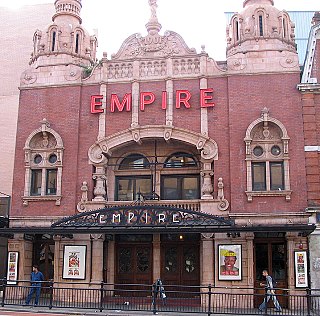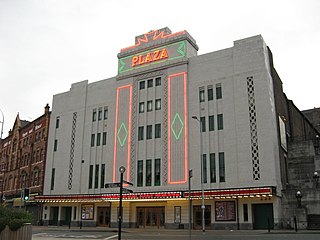Related Research Articles

The Royal Court Theatre is a theatre located at 1 Roe Street in Liverpool, England. The current Royal Court Theatre was opened on 17 October 1938, after fire destroyed its predecessor. It was rebuilt in Art Deco style and soon became Liverpool's premier theatre. The interior of the building has a nautical theme, in line with Liverpool's seafaring traditions. The design of the basement lounge was based on the Cunard liner Queen Mary until its conversion into the Studio space during renovations. There are three viewing levels within the main auditorium: the Stalls, the Grand Circle and the Balcony.

Buxton Opera House is in The Square, Buxton, Derbyshire, England. It is a 902-seat opera house that hosts the annual Buxton Festival and the International Gilbert and Sullivan Festival, among others, as well as pantomime at Christmas, musicals and other entertainments year-round. Hosting live performances until 1927, the theatre then was used mostly as a cinema until 1976. In 1979, it was refurbished and reopened as a venue for live performance.

The Theatre Royal is the oldest theatre in Glasgow and the longest running in Scotland. Located at 282 Hope Street, its front door was originally round the corner in Cowcaddens Street. It currently accommodates 1,541 people and is owned by Scottish Opera. The theatre opened in 1867, adopting the name Theatre Royal two years later. It is also the birthplace of Howard & Wyndham Ltd, owners and managers of theatres in Scotland and England until the 1970s, created by its chairman Baillie Michael Simons in 1895. It was Simons who as a cultural entrepreneur of his day also promoted the building of Kelvingrove Art Gallery and Museum and Glasgow's International Exhibitions of 1888 and 1901.

The Tivoli Theatre is a theatre in Aberdeen, Scotland, opened in 1872 as Her Majesty's Theatre and was built by the Aberdeen Theatre and Opera House Company Ltd, under architects James Matthews of Aberdeen and Charles J. Phipps, a London-based architect brought in to consult. The auditorium was rebuilt in 1897 by theatre architect Frank Matcham, but then closed temporarily in 1906, following the opening of the larger His Majesty's Theatre. The smaller theatre was extensively reconstructed in 1909, again by Frank Matcham, and re-opened in July 1910 as the Tivoli. The Tivoli was refurbished again in 1938.

The King's Theatre is located in Glasgow, Scotland. It was built for Howard & Wyndham Ltd under its chairman Baillie Michael Simons as a sister theatre of their Theatre Royal in the city and was designed by Frank Matcham, opening in 1904. The theatre is primarily a receiving house for touring musicals, dance, comedy and circus-type performances. The theatre also provides a prominent stage for local amateur productions. The King's Theatre also stages an annual pantomime, produced by First Family Entertainment. The theatre is currently operated by ATG Entertainment, under a lease from Glasgow City Council who own the building.

The Regent Theatre is a theatre in Stoke-on-Trent, England. Constructed in 1929 as a cinema, it is one of several theatres in the city centre and one of two operated by the Ambassador Theatre Group on behalf of Stoke-on-Trent City Council. The building was converted for full-time use as a theatre in 1999, and since then has hosted a number of shows and musicals. The theatre is also the northern base for the Glyndebourne Touring Opera.

The Alhambra Theatre is a theatre in Bradford, West Yorkshire, England, named after the Alhambra palace in Granada, Spain, which was the place of residence of the Emir of the Emirate of Granada. It was built in 1913 at a cost of £20,000 for theatre impresario Francis Laidler, and opened on Wednesday 18 March 1914. In 1964, Bradford City Council bought the Alhambra for £78,900 and in 1974, it was designated a Grade II listed building. It underwent extensive refurbishment in 1986. Today it is a receiving house for large-scale touring theatre of all types and the main house seats 1,456.

Tameside Hippodrome is a 1262 seat theatre located in Ashton-under-Lyne, Greater Manchester, England.

Blackpool Grand Theatre is a theatre in Blackpool, Lancashire, England. Since 2006, it has also been known as the National Theatre of Variety. It is a Grade II* Listed Building.

Hackney Empire is a theatre on Mare Street, in Hackney in the London Borough of Hackney. Originally designed by Frank Matcham it was built in 1901 as a music hall, and expanded in 2001. Described by The Guardian as "the most beautiful theatre in London" it is an Arts Council England National Portfolio Organisation.

The Liverpool Olympia is a venue in Liverpool, England, situated on West Derby Road next to The Grafton Ballroom.

The Plaza is a Grade II* listed art deco single-screen cinema and theatre in Stockport, Greater Manchester, England. It opened in 1932, its construction having involved the excavation of the sandstone cliff behind it. After an initial closure in 1966 and a subsequent period in use as a bingo hall by Rank Leiure, it has now been restored as a cinema and theatre, showing films and staging live shows.

The Marina is a theatre and cinema in Lowestoft, Suffolk, originally opened in the Victorian era. The venue has an auditorium seating 800. It plays host to major West End productions, top comedy, orchestral concerts, touring drama and musical productions, opera, ballet, music, dance and celebrity concerts as well as operating a successful cinema operation - boasting the largest screen and cinema auditoria in the town. The Marina annually hosts the largest professional pantomime on the East Anglian Coast.

The Southport Winter Gardens was a Victorian entertainment area located within the town of Southport, Merseyside. The original winter gardens comprised a theatre, opera house, aquarium, a small zoo, conservatory, promenades and halls situated under the grand glass domes.

Everyman Theatre is a theatre based in Regent Street, Cheltenham. There are two auditoria in the building - the 718 seat main auditorium and the 60 seat Studio Theatre, originally named The Ralph Richardson Studio after Ralph Richardson.

Brighton Hippodrome is an entertainment venue in Brighton, England. It was built in 1897 and closed in 2007.
Aberdeen has been the host of several theatres and concert halls through history. Some of them have been converted or destroyed over the years.

The New Theatre Royal is a Victorian Grade II* listed theatre in the heart of Portsmouth, England, with a capacity of 648. The theatre building was constructed in 1854 as Landport Hall. It was converted to a theatre two years later. It was rebuilt in 1884 by Charles J. Phipps and again in 1900 by Frank Matcham.

The Theatre Royal in Manchester, England, opened in 1845. Situated next to the Free Trade Hall, it is the oldest surviving theatre in Manchester. It was commissioned by Mancunian businessman John Knowles who wanted a theatre venue in the city.
The Empire Theatre was a theatre in Longton in Stoke-on-Trent, England. It was later a cinema and a bingo hall; it was destroyed by fire in 1992.